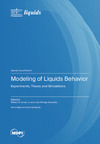Identificador persistente para citar o vincular este elemento:
https://accedacris.ulpgc.es/jspui/handle/10553/132054
| Título: | Modeling of Liquids Behavior: Experiments, Theory and Simulations | Coordinadores/as, Directores/as o Editores/as: | William E. Acree, Jr. Ortega Saavedra, Juan |
Clasificación UNESCO: | 331005 Ingeniería de procesos | Fecha de publicación: | 2023 | Editor/a: | MDPI | Resumen: | The subject of this Special Issue is the determination and modeling of the physical and thermodynamic properties of both pure liquids, as well as binary and ternary liquid mixtures containing organic and inorganic materials using modern experimental and computational methods. Special emphasis is given to studies that report the latest technical and theoretical results concerning the properties and processes of industrial significance. The authors of the fourteen papers contained in this Special Issue are experts in their respective fields of solution thermodynamics and computational chemistry, and they have made significant contributions to the understanding of solute–solvent and solvent–solvent molecular interactions in liquid solutions. They have collaborated to create an informative and valuable scientific resource for academicians, as well as scientists and engineers working in the chemical and pharmaceutical manufacturing sectors. Specific topics covered in the Special Issue include the prediction of drug molecules in both neat and binary solvent mixtures; preferential solvation of solvent molecules around a dissolved solute; the development of Abraham model correlations for describing solute transfer into three alkyl acetate mono-solvents; an atom additivity model to estimate molar refractivity and polarizability of organic compounds; a novel solution calorimetric method for determining enthalpies of fusion; deciphering the role of fluorous liquids through density and dynamic viscosity measurements; the extraction of valuable thermodynamic information from published databases using linear free energy relationships and equation-of-state thermodynamic models; estimation of surface tension and equivalent carbon atom number using solvation parameters; an artificial intelligence model and an adaptive neuro-fuzzy inference system for calculating the densities and refractive indices of binary ionic liquid mixtures containing common cations/anions; application of group contribution methods to calculate thermodynamic properties pertaining to the industrial cyclohexanone production; the importance of cavity creation for processes occurring in water; and thermodynamic modeling of mineral scaling in both high-temperature and high-pressure aqueous environments. Each paper provides valuable insight into the underlying fundamental principles that govern the studied processes. The predictive expressions and models presented in the published papers will enable practicing scientists and engineers to estimate physical and thermodynamic properties needed in industrial process design calculations. | URI: | https://accedacris.ulpgc.es/handle/10553/132054 | ISBN: | 978-3-0365-8009-8 | DOI: | 10.3390/books978-3-0365-8009-8 |
| Colección: | Libro |
Visitas
131
actualizado el 25-ene-2025
Descargas
169
actualizado el 25-ene-2025
Google ScholarTM
Verifica
Altmetric
Comparte
Exporta metadatos
Los elementos en ULPGC accedaCRIS están protegidos por derechos de autor con todos los derechos reservados, a menos que se indique lo contrario.
